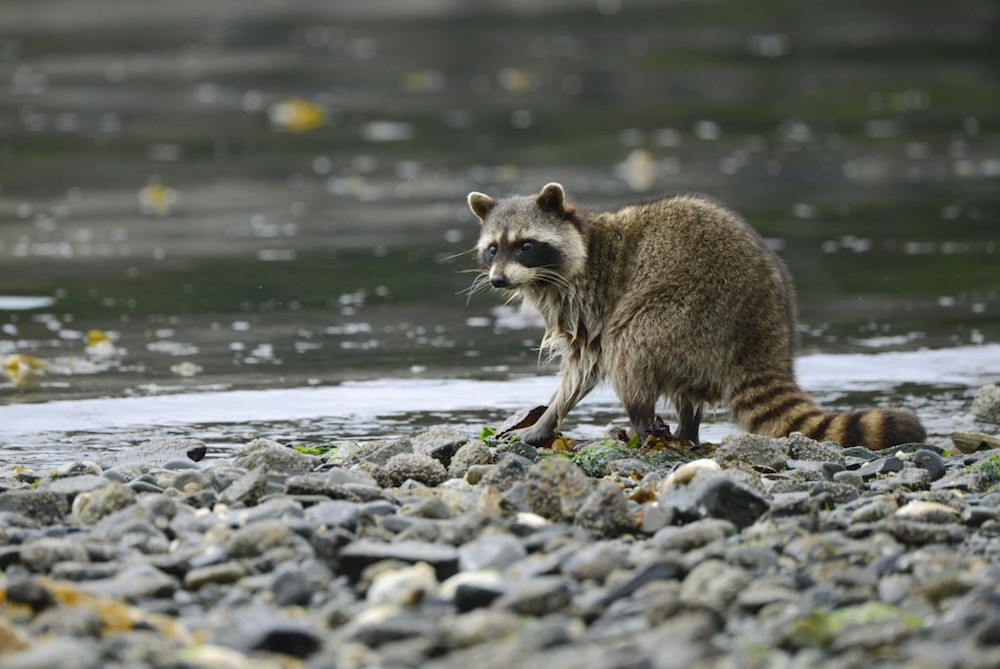
A predator's bark may indeed be worse than its bite, new research suggests.
Simply hearing a recording of wild dogs barking can keep wild raccoons from foraging along a shoreline of several small islands, according a new study.
That, in turn, fuels a population rebound in the raccoons' prey, such as crabs and fish. The findings could have implications for other ecosystems, where animals lower in the food chain quiver at the mere mention other top predators.
"When it comes to conserving biodiversity and maintaining healthy ecosystems, fear has its uses. By inspiring fear, the very existence of large carnivores on the landscape, in and of itself, can provide a critical ecosystem service human actions cannot fully replace, making it essential to maintain or restore large carnivores for conservation purposes on this basis alone," the researchers wrote in the paper, which was published today (Feb. 23) in the journal Nature Communications. [Video: Watch Raccoons Cower At the Sound of Dogs Barking]
Web of fear
Past studies had shown that even spiders with disabled mouthpieces, which could scare, but not physically harm, grasshopper prey, successfully cause grasshoppers to change their foraging behaviors enough to alter the whole plant community. But scientists were split as to whether the same fear-based ecology held sway at larger scales.
"There's been quite a bit of controversy over whether these cascading effects of fear have any real relevance for wildlife like large carnivores and their prey in real ecosystems," said Justin Suraci, an ecology doctoral candidate at the University of Victoria in Canada. "This is because previous attempts to study the cascading effects of fear in wildlife have been unable to disentangle the effects of fear from other factors affecting wildlife, such environmental change."
Get the world’s most fascinating discoveries delivered straight to your inbox.
For instance, many scientists believe the reintroduction of wolves to Yellowstone National Park has reduced elk overgrazing, allowing plants to regrow and beavers and songbirds to take up residence in the park once again. But opponents of wolf reintroduction have argued that other environmental changes, not the wolves' reign of terror, is responsible for the resurgence of a vibrant ecosystem in the park, Suraci said.
Suraci and his colleagues wanted to isolate the effects of terror in food webs involving larger creatures. To do so, the team studied the ecosystems on the Gulf Islands, an island chain off the coast of British Columbia, Canada. On the islands, wild raccoons prowl the shorelines for shore and red rock crabs and fish that live in the tidal zone. Historically, black bears, cougars and wolves hunted raccoons, but now that those predators have been exterminated, the only animals that prey on raccoons are wild domestic dogs, which local aboriginal people have kept for millennia, the researchers wrote.
While dogs likely don't kill that many raccoons and can't take the place of authentic top predators like cougars, "probably the vast majority of raccoons have been harassed by dogs (chased or barked out), which our data show is enough to instill a healthy predator fear," Suraci told Live Science in an email.
To see whether fear alone could impact raccoon behavior, Suraci's team played the sounds of wild dogs barking along the shoreline. As a control, they played the sounds of harbor seals, stellar sea lions and other pinnipeds along a separate shoreline. Throughout the month, they used cameras to track the number of raccoons prowling the beaches, as well as to survey the number of red rock and shore crabs and intertidal fish before and after the experiment.
When the raccoons heard the dog barks, they startled and shied away. Overall, raccoons on this fear-filled island spent 66 percent less time foraging in their favorite spots. The innocuous seal sounds, by contrast, produced no such effect.
The impact of those barking dog sounds reverberated through the food chain. At the end of this month-long experiment, the number of shore crabs nearly doubled, while there was an 81 percent jump in the number of intertidal fish and a 61 percent increase in red rock crabs, likely because fewer raccoons were scooping them up. Meanwhile, the small invertebrates that those crabs ate decreased, likely because the crustacean numbers increased.
The findings suggest that the fear provoked by top predators such as mountain lions and wolves may tie the whole food web together in surprising ways.
"The fear large carnivores inspire in their prey can account for a major component of their role in structuring ecosystems, reinforcing the value of large carnivore conservation in ensuring the continuation of this critical ecosystem service," the researchers wrote in the paper.
Follow Tia Ghose on Twitterand Google+. Follow Live Science @livescience, Facebook & Google+. Original article on Live Science.

Tia is the editor-in-chief (premium) and was formerly managing editor and senior writer for Live Science. Her work has appeared in Scientific American, Wired.com, Science News and other outlets. She holds a master's degree in bioengineering from the University of Washington, a graduate certificate in science writing from UC Santa Cruz and a bachelor's degree in mechanical engineering from the University of Texas at Austin. Tia was part of a team at the Milwaukee Journal Sentinel that published the Empty Cradles series on preterm births, which won multiple awards, including the 2012 Casey Medal for Meritorious Journalism.


